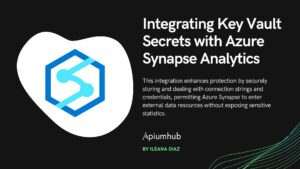Table of Contents
Maintaining privacy and ensuring secure access to critical resources is a critical task for IT teams in today’s multi-cloud and hybrid environments Azure Arc-enabling organizations to extend the functionality and security capabilities of Azure on-premises and in the cloud. Azure Key Vault Secrets integration with Azure Arc helps organizations safely manage secrets and deliver robust solutions for hybrid cloud deployments.
This article will examine the technical aspects of integrating Key Vault Secrets with Azure Arc. It will discuss the design and configuration processes, explore various use cases, and highlight the benefits of using these tools together. Finally, the article will provide an analysis of best practices and address potential limitations of this integration.
What is Azure Arc?
Azure Arc is a Microsoft deployment solution that allows organizations to expose their on-premise and multi-cloud resources to Azure, providing a centralized control plane for management Azure Arc supports Kubernetes, SQL Server, and virtual machine services on platforms such as Amazon Web Services (AWS) and Google Snake. It enables IT teams to deploy Azure services, governance, and security tools in disparate environments, delivering increased reliability and productivity.
What Does Azure Arc Do?
Key Capabilities of Azure Arc
- Unified Management Across Environments: Azure Arc allows you to bring resources such as servers, Kubernetes clusters, and databases into Azure’s management environment. This means you can monitor, secure, and manage these resources the same way you would for resources hosted directly on Azure.
- Hybrid and Multi-Cloud Security and Compliance: Azure Arc enables organizations to apply consistent security policies and configurations across all environments. It offers features such as Azure Policy and Azure Security Center, which can be applied to Arc-enabled resources, helping maintain compliance standards and security postures uniformly.
- Azure Services Anywhere: Through Azure Arc, you can deploy and run Azure services like Azure SQL Managed Instance and Azure App Services on-premises or in other clouds. This is particularly beneficial for organizations looking to keep certain workloads close to their data or customers or for scenarios with strict data residency requirements.
- Automated DevOps and Governance: Azure Arc provides centralized management for CI/CD pipelines, allowing DevOps teams to deploy applications across multiple environments through a single process. With GitOps for Kubernetes, for example, Azure Arc simplifies continuous deployment across hybrid and multi-cloud Kubernetes clusters.
- Extend Azure Data Services: For databases, Azure Arc allows you to run Azure SQL Managed Instance and PostgreSQL Hyperscale on-premises or in any cloud, benefiting from Azure’s automated updates, scaling, and data management services.
What is Azure Arc Agent?
The Azure Arc Agent is a piece of software that you use to install resources outside of Azure (such as on-premises servers, virtual machines, or Kubernetes clusters in other clouds) so that Azure Arc can manage them If the Azure Arc Agent is installed Once inside, products that are launched into Azure Can be managed like Azure-native products, using Azure tools and services such as Azure Schedule, Azure Monitor, and Azure Security Center.
Types of Azure Arc Agents
Azure Arc has different agents depending on the type of resource:
Azure Connected Machine Agent (for Servers): This agent is installed on Windows and Linux servers outside of Azure, allowing them to be represented as Azure resources. With this agent, you can apply Azure policies, monitor the server, and use security and compliance features for on-premises or multi-cloud servers as you would for Azure VMs.
Azure Arc Kubernetes Agent (for Kubernetes Clusters): This agent connects external Kubernetes clusters (like those running on-premises, AWS, or Google Cloud) to Azure. It allows you to manage these clusters from Azure, applying policies, configuring security, and using tools like Azure Monitor and Azure Security Center for Kubernetes.
Data Controller (for Azure Arc-enabled Data Services): When using Azure Arc to manage databases (like Azure SQL Managed Instance or PostgreSQL Hyperscale) outside of Azure, the Data Controller acts as the agent that facilitates the connection and manages deployment, monitoring, scaling, and updates of Azure data services on-premises or in other clouds.
How does the Azure Arc Agent work?
- Install the Agent: The Azure Arc Agent is installed on a target server, VM, or Kubernetes cluster, establishing a secure connection with Azure.
- Authentication and Connection: Once connected, the agent uses Azure’s identity and access management to authenticate, allowing secure, role-based access.
- Projection to Azure: The resource is projected into Azure’s control plane, where it is treated as an Azure resource.
Ongoing Management: Azure services like policy application, monitoring, and security can then be applied to the resource, keeping it under Azure’s unified management.
What is Azure Key Vault Secret?
Azure Key Vault is a cloud service that provides secure storage and management of sensitive information such as API keys, passwords, and certificates. Azure Key Vault Secret has a built-in feature that allows users to store and secure sensitive information across locations.
Key Vault Secrets supports robust encryption, access, and audit capabilities and enables organizations to store and manage secrets to ensure compliance with security standards Azure Key Vault Secrets’ integration with Azure Arc provides a solution for centralized and secure management of secrets in hybrid and multi-cloud systems.
Why Integrate Key Vault Secrets with Azure Arc?
Integrating Azure Key Vault Secrets with Azure Arc can solve various security and operational challenges in a hybrid or multi-cloud setup, such as:
- Centralized Management: Azure Key Vault allows for centralized storage and access control of secrets across different environments, reducing the risk of distributed secrets management.
- Enhanced Security: By leveraging Azure’s security controls, Azure Key Vault protects secrets with strong encryption and strict access controls, enabling organizations to maintain security standards across environments.
- Scalability: Azure Key Vault’s integration with Azure Arc allows large-scale organizations to scale their secrets management across global, distributed infrastructures without compromising security or incurring excessive management costs.
Streamlined Compliance: The use of Azure Key Vault in a hybrid environment ensures compliance with security and audit standards, while Azure Arc provides visibility and control across diverse infrastructures.
Technical Integration of Key Vault Secrets with Azure Arc
Integrating Key Vault Secrets with Azure Arc involves setting up access to Key Vault within an Arc-enabled Kubernetes cluster, enabling workloads running on Arc-enabled resources to retrieve secrets from Key Vault.
Prerequisites
- An Azure subscription with permission to create and manage resources.
- Azure Arc-enabled Kubernetes cluster with a supported Kubernetes version.
- An Azure Key Vault instance with Key Vault Secrets enabled.
Step 1: Configure Key Vault Access Policies
To allow Azure Arc to access Key Vault, configure access policies:
- Go to the Azure Key Vault instance in the Azure portal.
- Under Access policies, add a new policy allowing access to secrets.
- Grant Get and List permissions for secrets to the necessary service principal or managed identity associated with Azure Arc.
Step 2: Set Up an Identity for Arc-Enabled Kubernetes
Azure Arc uses managed identities to authenticate and access Azure resources securely:
- Create a managed identity for the Azure Arc-enabled Kubernetes cluster.
- Assign the managed identity appropriate permissions in Key Vault for accessing secrets.
- Configure the Kubernetes cluster to use the managed identity with Azure Arc.
Step 3: Deploy the Azure Key Vault Provider for Secrets Store CSI Driver
The Secrets Store CSI Driver allows for direct retrieval of Key Vault Secrets by workloads running on the Kubernetes cluster:
- Install the Azure Key Vault Provider for Secrets Store CSI Driver on your Arc-enabled Kubernetes cluster. This provider allows Kubernetes workloads to retrieve secrets directly from Key Vault.
bash
kubectl apply -f https://raw.githubusercontent.com/Azure/secrets-store-csi-driver-provider-azure/master/deployment/install-azure-provider.yaml
2. Configure the driver to use the managed identity associated with the Arc-enabled cluster.
Step 4: Link Secrets from Key Vault to Kubernetes Pods
After configuring the CSI Driver, you can define secrets to be retrieved from Key Vault:
- Define a SecretProviderClass in Kubernetes to specify the secrets from Key Vault that should be available to specific pods:
yaml
apiVersion: secrets-store.csi.x-k8s.io/v1alpha1
kind: SecretProviderClass
metadata:
name: azure-kvname
spec:
provider: azure
parameters:
usePodIdentity: "false"
keyvaultName: "your-keyvault-name"
cloudName: "" # Azure cloud name, leave blank for public cloud
objects: |
array:
- |
objectName: your-secret-name
objectType: secret # options: secret, key, or certificate
objectVersion: "" # leave empty for latest version
tenantId: "your-tenant-id"
2. Reference this SecretProviderClass in the Kubernetes deployment configuration for any pod requiring these secrets.
3. Deploy the pod, which will mount the secrets from Key Vault to the specified location, allowing the application to securely access them.
Key Use Cases for Kubernetes Workload and Azure Arc Integration using Azure Key Vault
1. Multi-Cloud Secret Management
Organizations with resources in multiple clouds can use Azure Arc to back up these resources to Azure and manage confidentiality in a centralized Key Vault instance. This mitigates the security risks associated with managing scattered secrets and ensures compliance in the cloud.
2. Consistent Security Across Hybrid Environments
For organizations with on-premises and cloud-based resources, integrating Kubernetes Workload with Azure Arc allows for standardized security infrastructure and streamlined deployment. This is especially valuable for delicate work that requires access control and strong computational techniques.
3. Streamlined DevOps in Kubernetes
Azure Arc-enabled Kubernetes clusters can access Key Vault Secrets directly, providing secure and scalable secret management within the DevOps pipeline. This eliminates the need for manual privacy settings and ensures that the secrets remain up-to-date.
Challenges and Limitations
- Managed Identity Limitations: While managed identities simplify authentication, they can add complexity when working across multiple tenants or Azure subscriptions.
- Dependency on Internet Connectivity: Azure Arc requires connectivity to Azure. For fully disconnected environments, additional configurations or alternative solutions may be necessary.
Potential Overheads in Setup: Configuring the Secrets Store CSI Driver and managing identities requires an understanding of both Kubernetes and Azure, which may be challenging for teams without in-depth Azure experience.
Conclusion
Azure Key Vault Secrets’ integration with Azure Arc provides a secure, scalable, and centralized solution for managing secrets in multi-cloud and hybrid environments by enabling consistent security practices across multiple infrastructures, organizations can reduce security risks, ensure compliance, and increase productivity. Key Vault and Azure Arch work seamlessly together to provide a robust environment for hybrid cloud deployments, providing a unified management plane with the flexibility and control needed for enterprise-level deployments
Despite some challenges, the combination of Kubernetes Workload and Azure Arc using Azure Key Vault Secrets remains an asset for organizations looking to streamline and optimize their privacy management processes across industries. With thoughtful design and best practices, enterprises can maximize the benefits of Azure Arc and Key Vault for modern, hybrid cloud deployments.
Author
-

I am a Computer Engineer by training, with more than 20 years of experience working in the IT sector, specifically in the entire life cycle of a software, acquired in national and multinational companies, from different sectors.
View all posts
More to Explore









